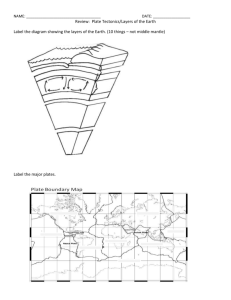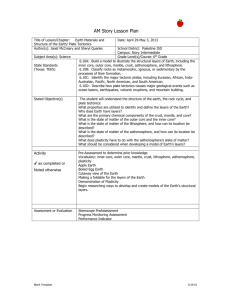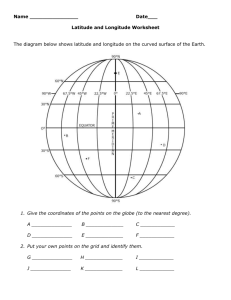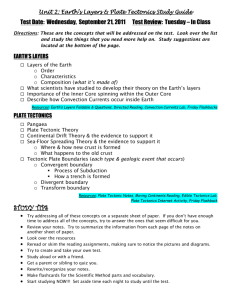Layers of the Earth and Plate Tectonics
advertisement
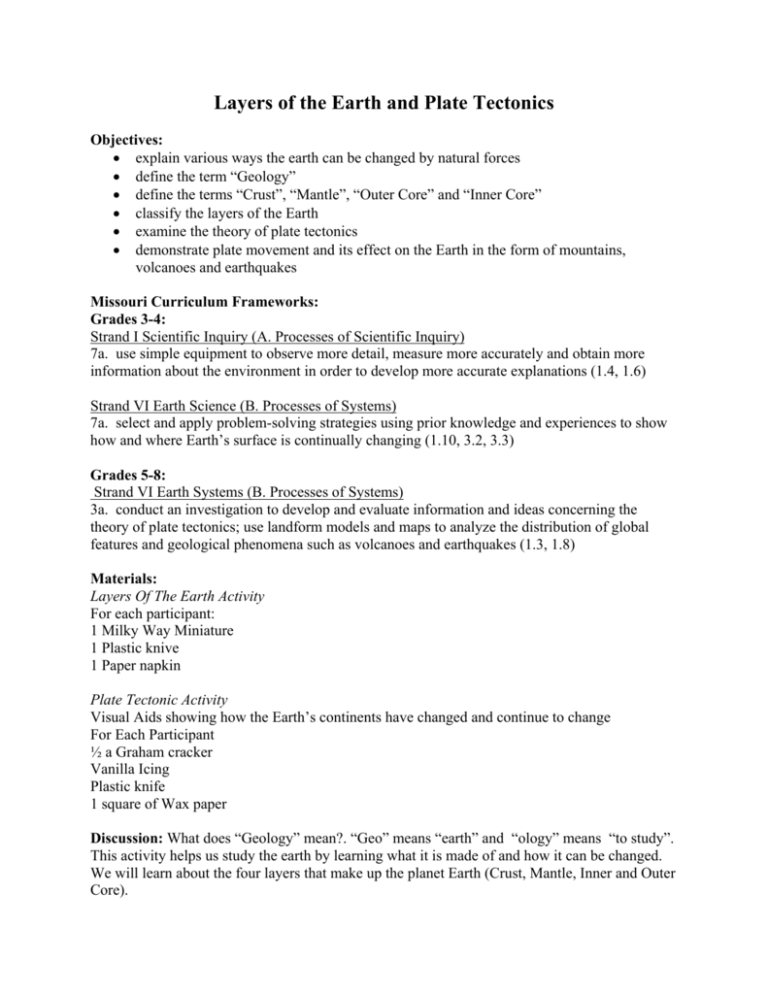
Layers of the Earth and Plate Tectonics Objectives: • explain various ways the earth can be changed by natural forces • define the term “Geology” • define the terms “Crust”, “Mantle”, “Outer Core” and “Inner Core” • classify the layers of the Earth • examine the theory of plate tectonics • demonstrate plate movement and its effect on the Earth in the form of mountains, volcanoes and earthquakes Missouri Curriculum Frameworks: Grades 3-4: Strand I Scientific Inquiry (A. Processes of Scientific Inquiry) 7a. use simple equipment to observe more detail, measure more accurately and obtain more information about the environment in order to develop more accurate explanations (1.4, 1.6) Strand VI Earth Science (B. Processes of Systems) 7a. select and apply problem-solving strategies using prior knowledge and experiences to show how and where Earth’s surface is continually changing (1.10, 3.2, 3.3) Grades 5-8: Strand VI Earth Systems (B. Processes of Systems) 3a. conduct an investigation to develop and evaluate information and ideas concerning the theory of plate tectonics; use landform models and maps to analyze the distribution of global features and geological phenomena such as volcanoes and earthquakes (1.3, 1.8) Materials: Layers Of The Earth Activity For each participant: 1 Milky Way Miniature 1 Plastic knive 1 Paper napkin Plate Tectonic Activity Visual Aids showing how the Earth’s continents have changed and continue to change For Each Participant ½ a Graham cracker Vanilla Icing Plastic knife 1 square of Wax paper Discussion: What does “Geology” mean?. “Geo” means “earth” and “ology” means “to study”. This activity helps us study the earth by learning what it is made of and how it can be changed. We will learn about the four layers that make up the planet Earth (Crust, Mantle, Inner and Outer Core). “Layers of the Earth” Activity 1. Place a Milky Way candy bar on a paper napkin. 2. Cut down the middle of the candy bar. • The chocolate on the top of the candy bar represents the crust of the Earth. This is the thinnest layer. It is made up of soil and rocks. The land we walk on and the land under the oceans are part of the crust. • The caramel layer represents the mantle. It is made up of hot molten rock. This molten rock is what erupts from volcanoes in the crust. • Notice the light brown layer and tell them it represents the outer core. It is made up of liquid iron. • The bottom layer of chocolate is the inner core of the Earth. This layer is made of solid iron and is the hottest part of the Earth. The temperature of the inner core is almost as hot as the sun. 3. Don’t forget to eat the layers of the Earth! Discussion: We will now look at how the Earth’s layers change as a result of plate tectonics. Plates are large sections of the Earth’s crust that slowly move over partially melted rock in the upper mantle. This movement explains how the Earth’s surface has changed over time and predicts how it will change in the future. This theory is called plate tectonics. It helps to explain the formation, movements, collusions, and destruction of the Earth’s crust. “Plate Tectonics” Activity 1. Spread frosting on wax paper to cover an area a bit larger than the graham cracker square. 2. Break the graham cracker on its seam to make 2 rectangles and place the 2 rectangles, touching, on top of the frosting. Note: The graham crackers represent the Earth’s crust, which is broken up into plates. The frosting represents the mantle. 3. Move the plates (crackers) apart to expose some of the mantle (frosting). This is called a spreading zone. When plates move apart, it creates cracks in the Earth called rift valley. Pulling apart of the plates allows hot, melted rock to come up through the crack in the earth. This is how a volcano’s opening is formed. 4. Push the plates together until the middle forms a ridge. When plates collide they create mountains. This is called a collision zone. An example is the Appalachian Mountains, which were formed when Africa collided with North America during formation of Pangea. 5. Slide the edges of the crackers against each other. The horizontal grinding and sliding of the plates causes earthquakes. This is called a shearing fault. A fault is a fracture in the earth’s crust. An example is the New Madrid Fault, which runs along the eastern border of Missouri. Earthquakes can, and have, occurred along this fault line. Layers of the Earth and Plate Tectonics Lab Write-up Name __________________ Date ___________________ Please answer the following questions using complete sentences. 1. What is geology? Layers of the Earth Activity 2. Label the layers of the earth using the following terms: crust, mantle, inner core and outer core. Please fill in the layers with the following colors: Crust= brown Mantle= yellow Outer core=orange Inner core=red 3. Illstrate and label the layers of the Milky Way candy bar that represent the different layers of the earth. 438 St. Louis Street * Springfield, MO 65806 * Phone: 417.862.9910 * Fax: 417.862.6898 www.discoverycenterofspringfield.org Plate Tectonics Activity 4. Please circle the arrow that indicate which way the earth crust is moving in order to form a rift valley, ridge, and a shearing fault. = graham crackers/ earths crust Rift valley Ridge Shearing Fault 5. Explain how the opening of a volcano is formed? ______________________________________________________________________________ ______________________________________________________________________________ ______________________________________________________________________________ 6. Explain how a mountain is formed? ______________________________________________________________________________ ______________________________________________________________________________ ______________________________________________________________________________ 438 St. Louis Street * Springfield, MO 65806 * Phone: 417.862.9910 * Fax: 417.862.6898 www.discoverycenterofspringfield.org Extension What is the name of the Fault that runs along the eastern border of Missouri? Has there ever been an earthquake that has occurred along this fault? If so, when? 438 St. Louis Street * Springfield, MO 65806 * Phone: 417.862.9910 * Fax: 417.862.6898 www.discoverycenterofspringfield.org

